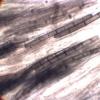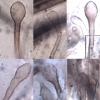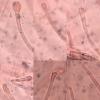
19-11-2025 13:04
 Bruno Coué
Bruno Coué
Bonjour,je sollicite votre avis pour la récote

17-11-2025 21:46
Philippe PELLICIERBonjour,Récolté sur bois pourrissant de feuillu

16-11-2025 21:09
 Robin Isaksson
Robin Isaksson
Anyone recognize this acc. to pictures.? Found on

18-11-2025 13:59
Nogueira HéctorNovember 14, 2025 Brazuelo (León) SPAIN Hymenosc

17-11-2025 19:14
herman lambertApothécie discoïde 0.6 cm diam., orangeFace hym�

17-11-2025 21:57
Philippe PELLICIERBonjour,Récolté sur bois de feuillu mort dur, no

14-11-2025 16:26
 Marian Jagers
Marian Jagers
Hello everyone, On dead wood of Cytisus scoparius

15-11-2025 23:22
Mario FilippaHello,this is what I think to be Hymenoscyphus mac

15-11-2025 20:25
 Riet van Oosten
Riet van Oosten
Hello, Found by Laurens van der Linde, Nov. 2025
Glutinoglossum
Malcolm Greaves,
05-12-2020 16:04
This sticky specimen has spores from 0-7 septate with about 1/3 being 3, 1/3 being 7 and the final third being split between 0,1,2,4,5 and 6. The average length was 74 (59-84). Both the paraphyses on the head and stem were bulbose and septate.
The best fit I can see is G pseudoglutinosum. Does this seem reasonable?
Thanks
Mal
Sabino Arauzo,
09-12-2020 21:54
Re : Glutinoglossum
Hi Malcolm,
the key in Fedosova et al. 2018 is not useful in all cases.
We have sequenced several collections with predominant 3, 7 or 3-7 septa and all belong to G. glutinosum.
It is almost impossible to distinguish these species without sequencing.
Sabino.
Malcolm Greaves,
10-12-2020 00:52
Re : Glutinoglossum
Thanks for that Sabino. A sample is on its way for DNA.
Does that mean you feel the species in the Fedosova work are not real species or that distinguishing features described are not accurate?
Thanks
Mal
Does that mean you feel the species in the Fedosova work are not real species or that distinguishing features described are not accurate?
Thanks
Mal




